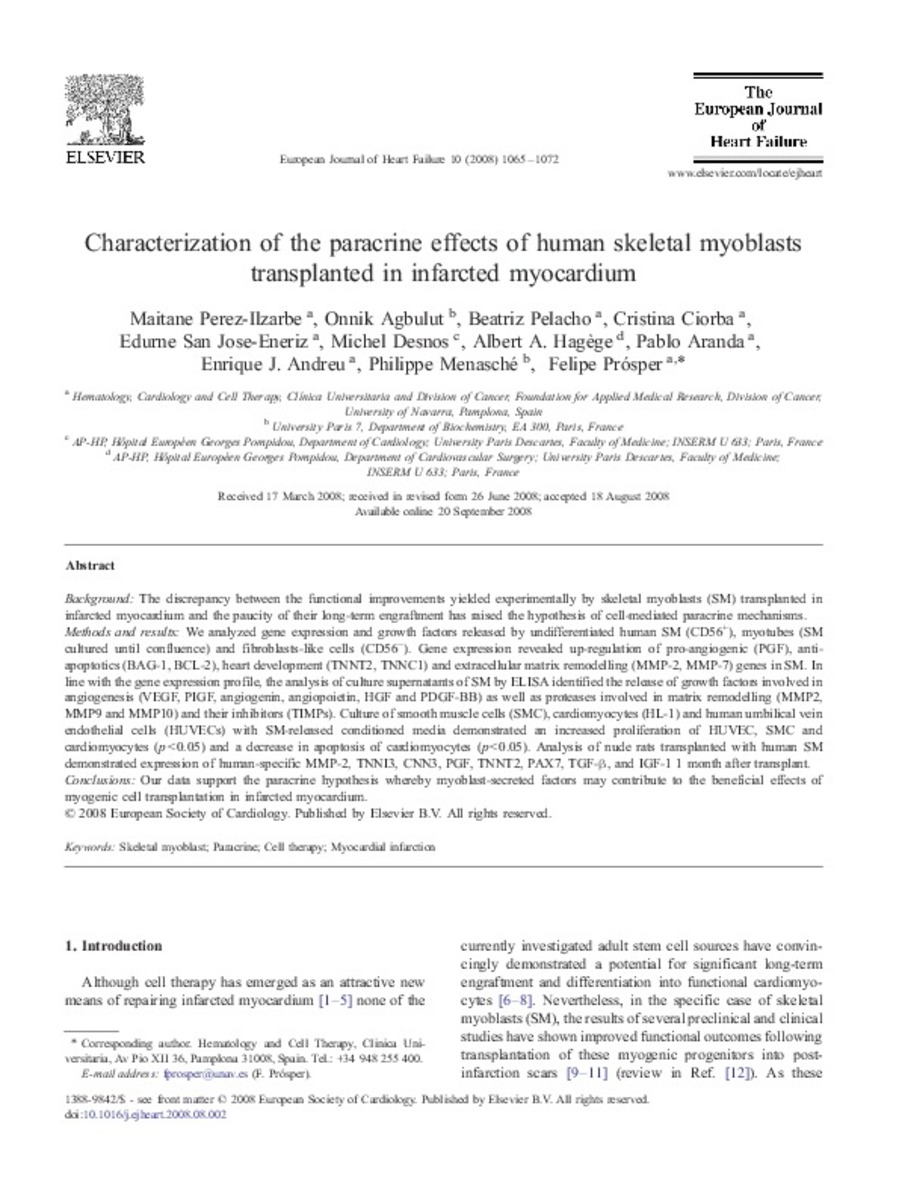Full metadata record
| DC Field | Value | Language |
|---|---|---|
| dc.creator | Perez-Ilzarbe, M. (Maitane) | |
| dc.creator | Agbulut, O. (Onnik) | |
| dc.creator | Pelacho, B. (Beatriz) | |
| dc.creator | Ciorba, C. (C.) | |
| dc.creator | San-Jose-Eneriz, E. (Edurne) | |
| dc.creator | Desnos, M. (M.) | |
| dc.creator | Hagege, A.A. (A. A.) | |
| dc.creator | Aranda, P. (P.) | |
| dc.creator | Andreu, E.J. (Enrique José) | |
| dc.creator | Menasche, P. (Philippe) | |
| dc.creator | Prosper-Cardoso, F. (Felipe) | |
| dc.date.accessioned | 2011-04-20T14:10:29Z | - |
| dc.date.available | 2011-04-20T14:10:29Z | - |
| dc.date.issued | 2008 | - |
| dc.identifier.citation | Pérez-Ilzarbe, M., Agbulut, O., Pelacho, B., Ciorba, C., et al. Eur. j. heart fail 2008; 10: 1065–1072 | es_ES |
| dc.identifier.issn | 1388-9842 | - |
| dc.identifier.uri | https://hdl.handle.net/10171/17830 | - |
| dc.description.abstract | The discrepancy between the functional improvements yielded experimentally by skeletal myoblasts (SM) transplanted in infarcted myocardium and the paucity of their long-term engraftment has raised the hypothesis of cell-mediated paracrine mechanisms. Methods and results: We analyzed gene expression and growth factors released by undifferentiated human SM (CD56+), myotubes (SM cultured until confluence) and fibroblasts-like cells (CD56−). Gene expression revealed up-regulation of pro-angiogenic (PGF), antiapoptotics (BAG-1, BCL-2), heart development (TNNT2, TNNC1) and extracellular matrix remodelling (MMP-2, MMP-7) genes in SM. In line with the gene expression profile, the analysis of culture supernatants of SM by ELISA identified the release of growth factors involved in angiogenesis (VEGF, PIGF, angiogenin, angiopoietin, HGF and PDGF-BB) as well as proteases involved in matrix remodelling (MMP2, MMP9 and MMP10) and their inhibitors (TIMPs). Culture of smooth muscle cells (SMC), cardiomyocytes (HL-1) and human umbilical vein endothelial cells (HUVECs) with SM-released conditioned media demonstrated an increased proliferation of HUVEC, SMC and cardiomyocytes (pb0.05) and a decrease in apoptosis of cardiomyocytes (pb0.05). Analysis of nude rats transplanted with human SM demonstrated expression of human-specific MMP-2, TNNI3, CNN3, PGF, TNNT2, PAX7, TGF-β, and IGF-1 1 month after transplant. Conclusions: Our data support the paracrine hypothesis whereby myoblast-secreted factors may contribute to the beneficial effects of myogenic cell transplantation in infarcted myocardium. © 2008 European Society of Cardiology. Published by Elsevier | es_ES |
| dc.language.iso | eng | es_ES |
| dc.publisher | Oxford University Press | es_ES |
| dc.rights | info:eu-repo/semantics/openAccess | es_ES |
| dc.subject | Skeletal myoblast | es_ES |
| dc.subject | Paracrine | es_ES |
| dc.subject | Cell therapy | es_ES |
| dc.subject | Myocardial infarction | es_ES |
| dc.title | Characterization of the paracrine effects of human skeletal myoblasts transplanted in infarcted myocardium | es_ES |
| dc.type | info:eu-repo/semantics/article | es_ES |
| dc.relation.publisherversion | http://eurjhf.oxfordjournals.org/ | es_ES |
Files in This Item:
Statistics and impact
Items in Dadun are protected by copyright, with all rights reserved, unless otherwise indicated.






